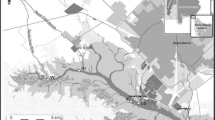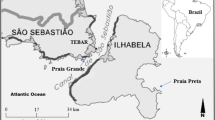Abstract
The assessment of environmental pollution of the coastal areas of the Malaysian Peninsula was done by analyzing the contents of the heavy and trace elements in the bivalves blood clams (Anadara granosa) and green mussels (Perna viridis) and sediments at twenty-two sampling stations to look for prevailing trends. Heavy and trace elements analyzed in this study were As, Cd, Cr, Cu, Pb, Se and Zn. Two techniques, namely the neutron activation analysis (NAA) and atomic absorption spectrophotometry (AAS) were used in the quantitative determination of the heavy metals while Marine Sediment Reference Material (BCSS) and Lobster Hepatopancreas (TORT-1) provided the certified reference materials in the quality assurance control. The potential use of these bivalves as suitable bio-indicators was evaluated from correlation tests based on the concentrations of heavy and trace elements in the sediment-metals system to those in the bivalves.
Similar content being viewed by others
References
P. A. Butler, L. Andren, G. J. Bonde, A. Jernelov, D. J. Reisch, Monitoring Organisms, in: Food and Agricultural Organization Technical Conference on Marine Pollution and its Effects on Living Resources and Fishing, Rome, 1970, M. Ruivo (Ed.), Supplement 1: Methods of Detection, Measurement and Monitoring of Pollutants in the Marine Environment,. London Fishing (Books) Ltd., 1971, p. 101; 12.
D. J. H. Phillips, Environ. Pollut., 13 (1977) 281.
E. D. Goldberg, Mar. Pollut. Bull., 6 (1975) 111.
I. M. Davies, J. M. Pirie, Mar. Biol., 57 (1980) 87.
R. Manly, W. O. George, Environ. Pollut., 14 (1977) 139.
C. R. Boyden, J. Mar. Biol. Ass. U.K., 57 (1977) 675.
E. D. Goldberg, V. Y. Bowen, J. W. Farrington, G. Harvey, J. H. Martin, P. L. Parker, R. W. Risebrough, M. A. William-Robertson, E. Schneider, E. Gamber, Environ. Conservation, 5 (1978) 101.
M. Martin, B. J. Richardson, Mar. Pollut. Bull., 22 (1991) 533.
Ministry of Health, Food Act., 1983 and Food Regulations, 1985 (Revised), Malaysia, 1985.
B. C. Han, W. L. Jeng, T. C. Hung, M. S. Jeng, Environ. Toxicol. Chem., 13 (1994) 775.
D. J. H. Philips, D. A. Segar, Mar. Pollut. Bull., 17 (1986) 10.
P. S. Rainbow, D. J. H. Philips, Mar. Pollut. Bull., 26 (1993) 593.
A. M. Yusof, A. K. H. Wood, J. Radioanal. Nucl. Chem., 167 (1993) 341.
A. M. Yusof, Z. B. Ikhsan, A. K. H. Wood, J. Radioanal. Nucl. Chem., 179 (1994) 277.
A. M. Yusof, N. A. Rahman, A. K. H. Wood, Biol. Trace Elem. Res., 43 (1994) 2.
A. M. Yusof, C. R. J. Ismail, Malays. J. Anal. Sci., 3 (1997) No. 1, 49.
U. Forstner, G. T. W. Wittmann, Metal Pollution in the Aquatic Environment, Springer Verlag, Berlin, 1983.
W. Salomon, U. Forstner, Metals in the Hydrocycle, Springer Verlag, Berlin, 1984.
J. Glover, O. Levander, J. Parizek, V. Vouk, Handbook on the Toxicology of Metals, Elsevier, Amsterdam, 1979, p. 555.
C. R. C. Sheppard, Mar. Poll. Bull., 8 (1977) 163.
Author information
Authors and Affiliations
Rights and permissions
About this article
Cite this article
Yusof, A.M., Yanta, N.F. & Wood, A.K.H. The use of bivalves as bio-indicators in the assessment of marine pollution along a coastal area. Journal of Radioanalytical and Nuclear Chemistry 259, 119–127 (2004). https://doi.org/10.1023/B:JRNC.0000015816.16869.6f
Issue Date:
DOI: https://doi.org/10.1023/B:JRNC.0000015816.16869.6f




